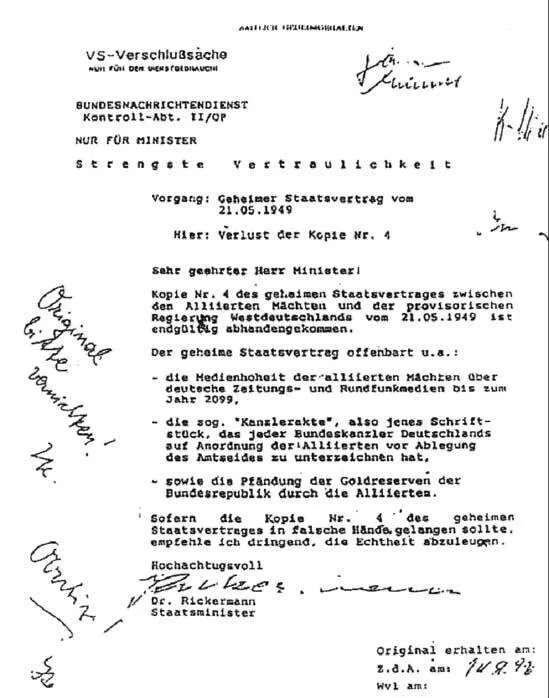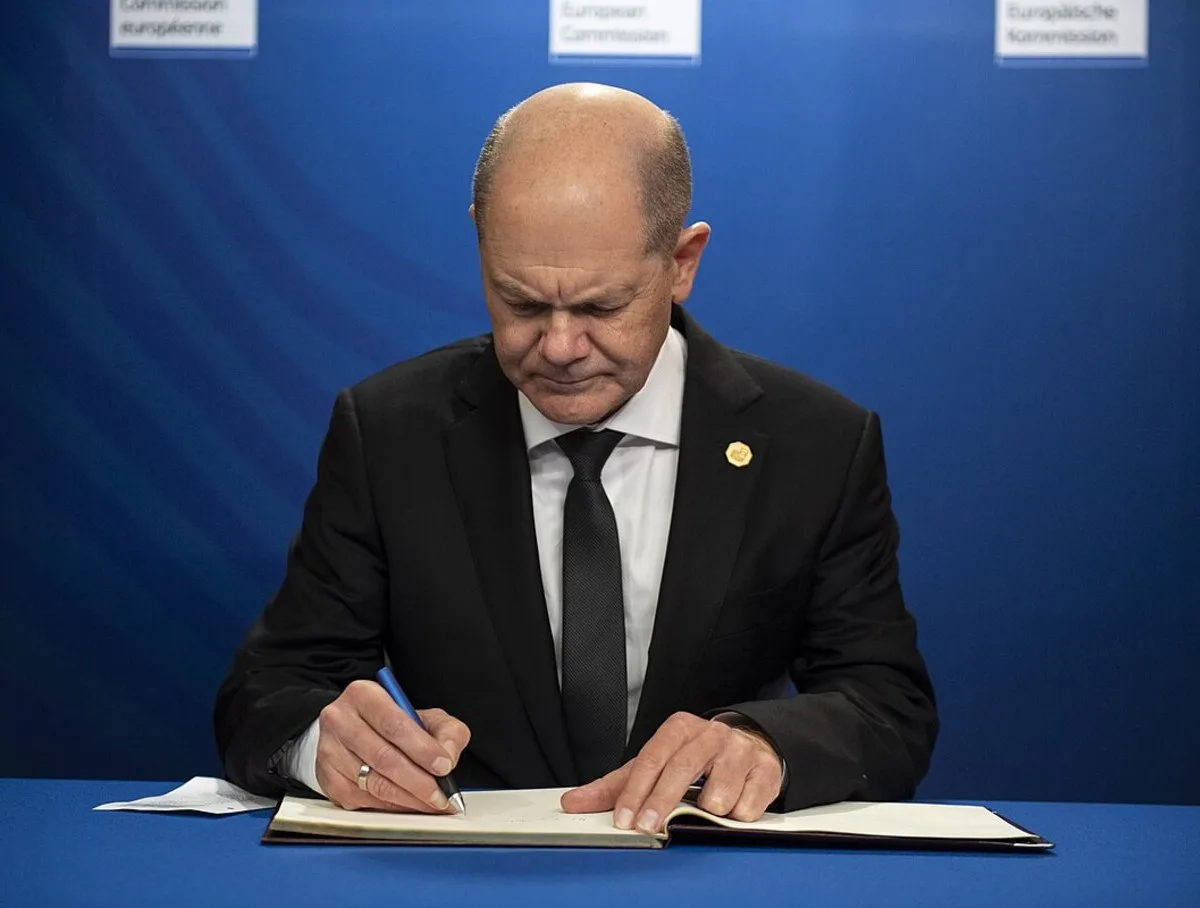On the Internet you can find references to a secret treaty, according to which the Allied powers in 1949 allegedly imposed restrictions on the sovereignty of the Federal Republic of Germany for 150 years. It is alleged that each Federal Chancellor, before taking the oath, signs this act, recognizing the primacy of the United States, Great Britain and France. We figured out how likely the existence of such a document is.
Russian media also wrote about the Chancellery Act (for example, “Moskovsky Komsomolets" and newspaper "Tomorrow"), and the historical encyclopedic project "Chronos", and bloggers in LiveJournal And "Zene" In all these publications, the existence of such a document was not questioned and was cited as evidence of the dependence of modern Germany on the “Anglo-Saxons” (that is, the USA, Great Britain and supranational structures, which conspiracy theorists usually write about).
Secret document
The first person to talk about the Chancellor Act is considered to be Major General Gerd-Helmut Komossa, the former head of the German military counterintelligence service (1977–1980). In 2007, his book “German Map: Secret Service Secret Game", which contains such a fragment: “The Federal Intelligence Service has assigned the secret state treaty of May 21, 1949 the highest level of secrecy. The treaty laid down the fundamental restrictions imposed by the victors on the sovereignty of the Federal Republic for the period until 2099. <...> The Allied Powers were also assigned the right to exercise complete control over the German media... The treaty provided that before taking the oath of office, each Federal Chancellor of Germany taking office, by order of the Allies, was required to sign the so-called Chancellor Act. In addition, the Allies seized the gold reserves of the Federal Republic."
The book itself turned out to be scandalous. Komossa, recalling his years of service in the Wehrmacht (1943–1945), spoke about the heroism of the soldiers of the Nazi army and complained about ungrateful descendants and allies who “denigrated” the image of the “valiant German soldier.”
The choice of publishing house Ares-Verlag is also noteworthy. In 1917, the Austrian entrepreneur Leopold Stocker founded a publishing house that initially published books about farming, but by 1930 Leopold Stocker Verlag published mostly nationalist and anti-Semitic literature. Publishing house continued his work after World War II, alternating books on animal husbandry with far-right writings. In 2004, the grandson of the company's founder, Wolfgang Dvorak-Stocker, registered the trademark Ares-Verlag for the publication of “works on historical topics.” The publisher also publishes a magazine Neue Ordnung (“New Order” - German; now it is called Abendland - “West”), in which articles of a right-wing radical and revisionist orientation are published.
Komossa in his book did not limit himself to describing the Act of Chancery - he attached a document that, as he claimed, proved the existence of a secret treaty.

The document typed is not the Chancellery Act itself, but a message supposedly from ministerial correspondence. It is addressed to an unnamed minister and signed by the Minister of State, Dr. Rickerman. The first paragraph states that one of the copies of the secret state treaty between the military allies and the transitional government of West Germany dated May 21, 1949 has disappeared. Then the contents of the act are retold.
This secret state agreement stipulated primarily the following:
- Allied ownership of German newspapers, radio and television until 2099;
- the so-called Chancellor’s Act, that is, a written document that each federal chancellor, at the request of the allies, signs before taking the oath;
- Allied possession of the gold reserves of the Federal Republic.
At the end of the text it is noted that if a document falls into the wrong hands, its authenticity should be denied.
Official reaction
The publication of Komossa's book in 2007 did not go unnoticed. At first, right-wing radical publications wrote about her and the sensational document. Soon Angela Merkel was asked about the Chancellery Act on her website. Press service of the Federal Chancellor answered: “The secret state treaty you mentioned belongs to the realm of legends. This state contract does not exist. And of course, the Chancellor did not need to sign the so-called Chancellor’s Act on the orders of the Allies before taking the oath.”
Then the question of the existence of the Chancellor Act was raised in the Bundestag. In 2009, a deputy from the Union 90/Greens faction, Hans-Christian Ströbele, inquired about the authenticity of the document. He received an official response from the Parliamentary Secretary of State Peter Altmaier. Firstly, Altmaier said, this is a fake, such an agreement does not exist and never has existed. Secondly, in 1990, all Allied obligations towards Germany were revised by the so-called “2 + 4” agreement - an agreement on a final settlement in anticipation of the country’s reunification. This agreement canceled the remnants of the occupation status of the Federal Republic of Germany and the German Democratic Republic, as well as all privileges of the allies (USSR, USA, France and Great Britain) in Germany. The united country received full sovereignty over all its internal and external affairs. Details about the status of Germany and relations with its allies “Verified” wrote after Russian President Vladimir Putin said in January 2023 that legally the United States allegedly never formalized the completion of the occupation of Germany.
Origin of the document
When doubts arise about the authenticity of a document, many details are important, including its origin. Theoretically, Major General Komossa, as the head of Military Counterintelligence (MAD), could have access to secret papers, but in the book he does not explain how the letter from the Minister of State came to him. After the publication of the "German Map", the publication Junge Freiheit asked the author this question. He forwarded a copy of the letter to the editors and tried to eliminate the omissions. His answer is newspaper published January 18, 2008.
Komossa said his words were misinterpreted and he supposedly did not mean at all that Germany still had to report to the Allies. As for the ministerial letter itself, the major general explained its origin as follows: “I used the so-called BND (Federal Intelligence Service) document, to which I had access due to my official position. However, I never verified the authenticity of these papers, and even today I do not know whether these documents are genuine or fake. Personally, I lean towards the second option, and it was a big mistake on my part not to note this in the book.”
But even this justification is dubious. First, due to his position as head of MAD, which reports to the Ministry of Defense, Komossa was unlikely to have access to classified documents from another intelligence service reporting directly to the Federal Chancellor. Secondly, in the lower right corner of the document there is a date - 1992. Komossa left the post of head of MAD in 1980, and by 1992 he had already retired.
The mysterious document, which actually records the vassal status of the Federal Republic of Germany in relation to the allies, has been mentioned more than once in various sources. In 1999, a right-wing extremist magazine Unabhängige Nachrichten announced the release of a sensational book by Professor James Shirley, in which he was supposed to talk about certain secret protocols to the Basic Law of Germany. However, neither then nor later could a historian or political scientist with that name be found, and the book was not published and is unlikely to have ever existed.
In 2009, the closest associate of Chancellor Willy Brandt (held this position from 1969 to 1974), former minister Egon Bahr published an article in the weekly Die Zeit, in which he spoke about a strange episode with the signing of certain letters. According to Bahr, Brandt, shortly after taking the oath, said that three letters addressed to the ambassadors of the United States, France and Great Britain were brought to him for signature. They required confirmation of certain reservations established by representatives of the victorious powers on May 12, 1949, that is, in essence, to agree with the limitation of the sovereignty of the Federal Republic of Germany. At the same time, the bar did not talk about the Chancellor’s Act, nor that it had to be signed before the oath.
Unknown minister, font from grandma's album and other errors
Many questions - both from a technical and a logical point of view - arose among experts and about the ministerial letter itself from the book of Komossa. Its copy was analyzed in detail by a variety of experts. One of them - employee of the University of Göttingen Holger Berwinkel, another - far-right revisionist historian Klaus Nordbruch. Both came to the same conclusions: the ministerial letter supposedly proving the existence of the Chancellery Act was a crude fake.

Let's return once again to the photograph of the letter. In the upper left corner the agency is indicated - Bundesnachrichtendienst (BND, Federal Intelligence Service). Handwritten notes are left in the margins. Most of them are illegible (intentionally, as believes Berwinkel), two notes on the left read: “Please destroy the original!” and “To the archive.”
Historians have discovered many inconsistencies. We will present the most significant of them.
Technical errors
- In 1996, an official letter typed on a typewriter looks like an anachronism.
- The sender indicated the control department (Kontroll-Abteilung) without mentioning the department to which it belongs.
- The status “Classified Information - For Official Use Only” (Verschlußsache - Nur für den Dienstgebrauch) in the upper left corner is reinforced by the mark at the top center “Officially Secret” (Amtlich geheimgehalten). This is an impossible combination. According to the rules of German document flow, the mark of official secrecy is compatible only with the marks “Top Secret”, “Secret” and “Confidential”.
- The template receipt mark in the lower right corner (z.d.A. - zu den Akten) looks strange for an outgoing document.
- The handwritten font of the notes in the margins is an imitation of the outdated Prussian Sütterlin, which was taught in the first half of the twentieth century. As Berwinkel puts it, to a paleographer in an official document from the 1990s, it looks like a funny old font from grandma's poetry album.
- The main text of the document is shifted to the center, as if deliberately leaving space for sweeping handwritten notes.
Factual errors
- The sender of the letter is Minister of State Dr. Rickerman. A person with that last name has never held such a post.
- There is no post of state minister in the BND structure. Minister of State (Staatsminister) is the official title parliamentary secretaries of state under the Federal Chancellor and the Federal Minister of Foreign Affairs. The people who head German ministries are called federal ministers (Bundesminister), and the BND is led by its president (Präsident).
Logical errors
- The handwritten notes “Destroy” and “Archive” contradict each other.
- For some reason, the sender retells to the addressee the contents of the Chancellery Act, which he should already know.
- The Federal Republic of Germany, mentioned in the document, was formed on May 23, 1949, two days after the supposed signing of the Chancellery Act, which gives this name to the country.
- By 1992, Germany's relations with its allies had been revised several times (for more details, see this analysis "Verified"), so it is unclear why the letter contains a reference to 1949.
It is worth mentioning separately that there are two photographs of the ministerial letter on the Internet. In one of the versions, typos were corrected and indentations were put in order (for example, between numbers in dates). As a result, the length of the lines in the two copies is different, while all handwritten notes are identical. This allows even conspiracy theorists to make a clear conclusion that at least one letter is a fake.

For almost two decades, the story of the Chancellor Act has become very popular among conspiracy theorists in Germany. The belief in the existence of such a document fuels the revanchist sentiments of the nationalist part of German society - especially those who, like retired Major General Komossa, consider the guilt for the crimes of the Third Reich to be an ideology imposed by the victors.
Moreover, the only document allegedly proving the existence of the Chancellor’s Act. - not the most accurate fake. This is evidenced by numerous technical, factual and logical errors made by the drafters of the letter. Thus, fantastic details were added to the historical fact (the influence of the Allies on the politics of the Federal Republic of Germany until a certain time) to create a conspiracy theory.
Cover photo: Lukasz Kobus / European Union
Read on topic:
If you find a spelling or grammatical error, please let us know by highlighting the error text and clicking Ctrl+Enter.






